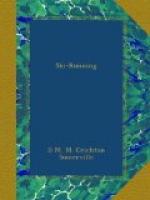To draw the sledge along, join a lap thong or sealskin or rope or puttee to the outer Ski tips, and also to the ends of the stick across them. In order to prevent this from pulling these Skis forward too much it is well to tie a string to the inner Ski tips also and join them to the pulling rope.
Another rope or thong should be attached to the stick and centre toe irons, so that this can be held from behind to prevent the sledge travelling too fast downhill. Experienced runners will be able to travel on Skis while getting this sledge down, but beginners will do well to wade on foot, especially the rear man, who has to control the speed. Neither the pulling nor control rope should be attached to the body of the person holding it because a sudden jerk may pull him over and the sledge be stopped suddenly with a jar to the person hurt.
Most club huts are provided with excellent ambulance sledges, which may be used, and which should be conscientiously returned to the Rettungschef of the locality.
There is a Rettungschef in every mountainous district whose duty it is to help with accidents when these are reported to him. He arranges to send out Guides and porters with an ambulance sledge to the assistance of any party in trouble. If, therefore, your accident be a serious one, and you are far from home, the wisest plan may be to send one or two of the best runners down to the nearest village for help, while the remainder stay with the injured person. For this reason it is always unwise to go out with fewer than three in a party. Five or six are a better number on a long day’s run.
Remember the people waiting at home, and when you have made arrangements for help to go to your party ring up your friends and tell them what has happened and what you have arranged. Having often seen the anxiety of relations and friends when their party comes home late, I know how important this is. Even if you are only delayed for some small reason such as a train being late, it is kind to ring up, and this is easily done, as there are telephones in almost every village.
While on this subject I would again like to urge that before going off on an expedition of any length the Concierge and someone should be told in writing the destination, the route, and the hour anticipated for return. Then, if the party does not turn up and no news comes through, a search party can be sent out with some hope of finding them within a reasonable time. Time is very important in January and February, when the weather is cold, as people can be badly frost-bitten if benighted.
Search parties are expensive luxuries, as it is risky work for the Guides, who deserve to be well paid for it. I have only once followed a Rettungschef with his five assistants and their ambulance sledge, and shall never forget the pace at which their lantern went ahead of us, dancing like a will-of-the-wisp. A runner had come home at 5 p.m. with news that one of the party had hurt his knee some four miles from home. This runner had already wisely rung up the Rettungschef from the first house he came to, and a party of Guides was being collected. I decided to go out with some friends in case the accident was a serious one and we could bring the remainder of the party home, and so save the Guides that duty. They were all beginners who were benighted.




